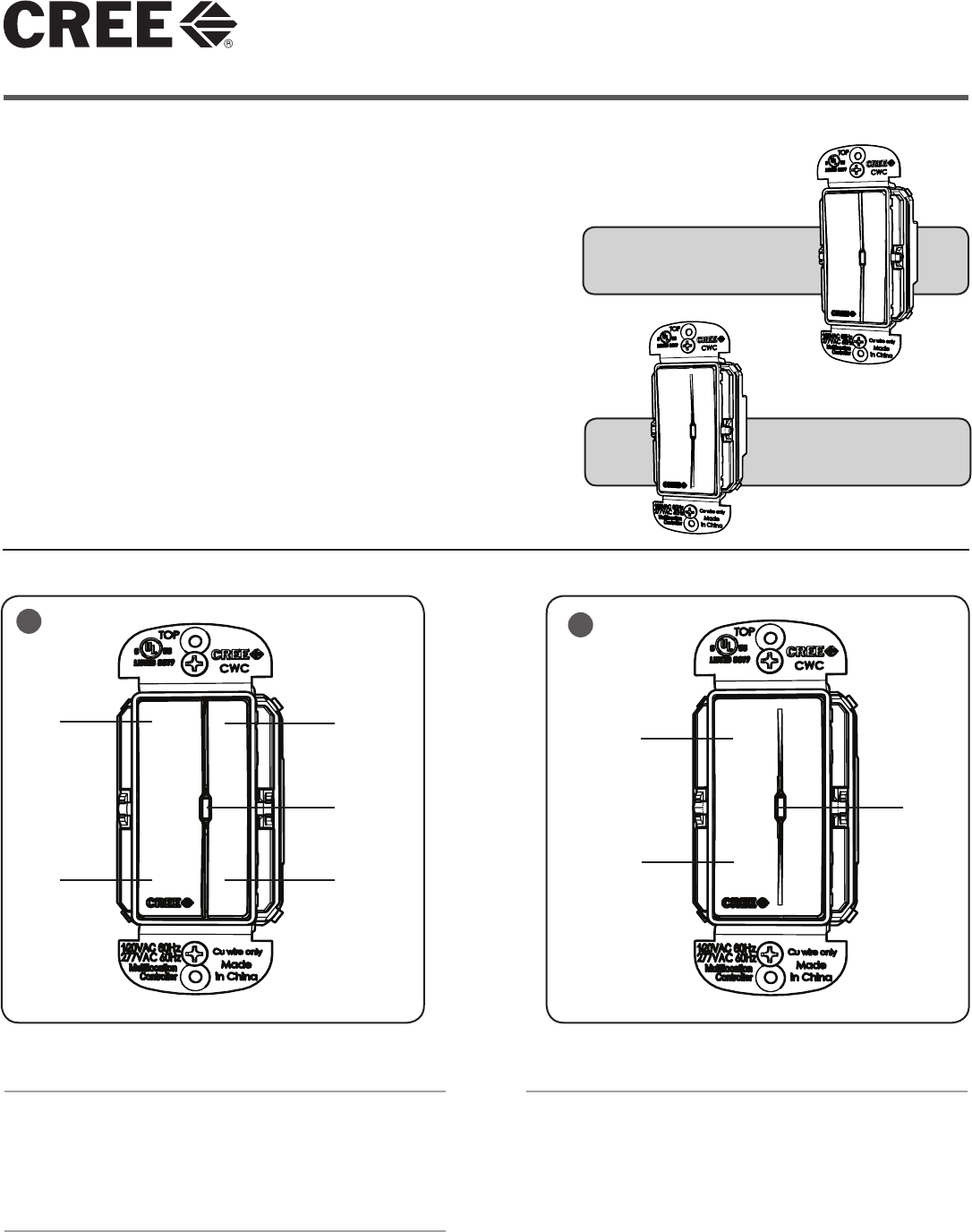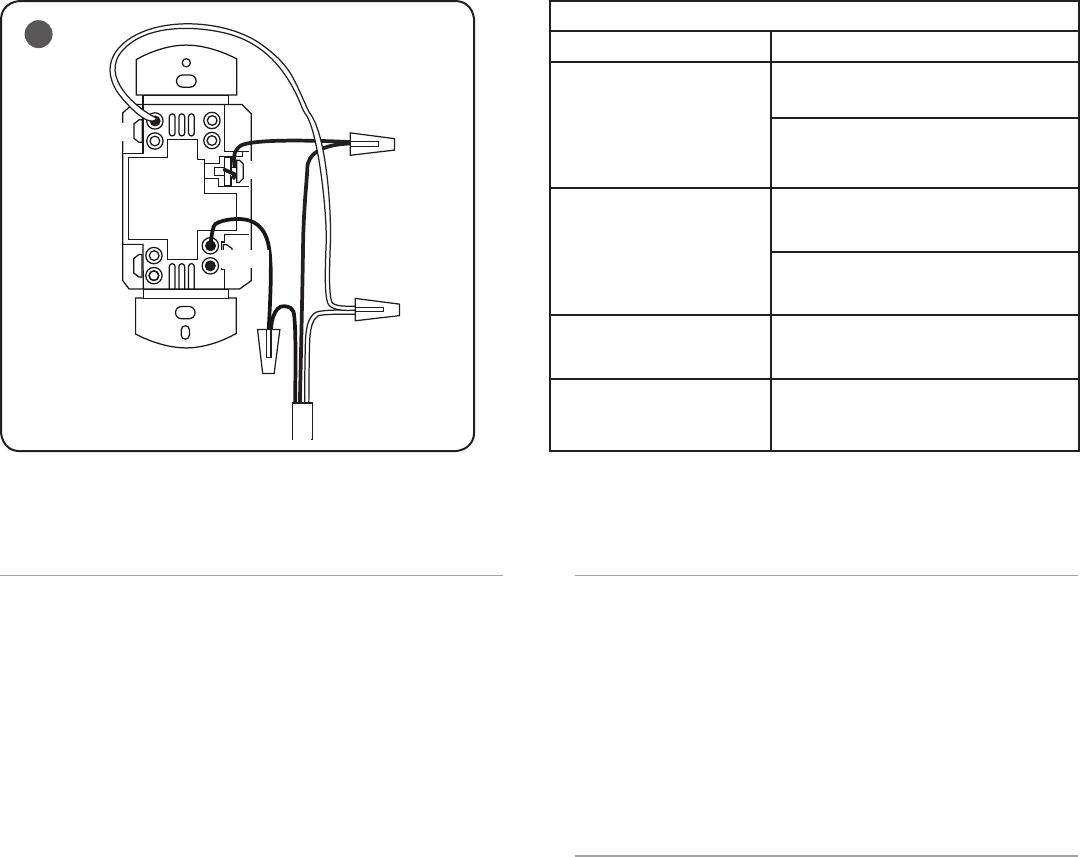Ideal Lighting CREE Lighting CWC WALL SWITCH User Manual Installation
Cree, Inc WALL SWITCH Installation
Contents
- 1. Installation
- 2. User Manual
Installation

LPN000180_H
1 of 3
INSTALLATION INSTRUCTIONS
Cree Wireless Wall Controls With SmartCast™ Technology
Wireless Dimmer and Wireless Switch
Includes: CWD-CWC-XX and CWS-CWC-XX
IMPORTANT SAFEGUARDS
When using electrical equipment, basic safety precautions should always be
followed including the following:
READ AND FOLLOW ALL SAFETY INSTRUCTIONS
1. Before installing wall controls turn off the power at the circuit breaker.
2. These wall controls must be installed in accordance with the national and
local building codes and electrical wiring codes including wiring methods
and wiring connections. If you are not familiar with these codes and
requirements, consult a qualied electrician.
3. Indoor use only and suitable for damp locations.
4. Any changes or modications to these devices not explicitly approved by
manufacturer could void your authority to operate this equipment.
SAVE THESE INSTRUCTIONS FOR FUTURE REFERENCE
• Voltage: 120-277V, 60Hz
• Depth in Wall: 1.5"
• For ease of installation, Cree recommends the use of a deep wall box.
UNIT DESCRIPTION
The Cree Wireless Wall Controls are used with other
SmartCast™ Technology enabled devices to provide wireless
control of LED luminaires. The Cree Wireless Wall Controls
provide on, off, and dimming control options.
LOAD TYPES
Cree Wall Controls support Cree SmartCast™ Technology
enabled devices only.
WALL CONTROLS FEATURES
• The Cree Wireless Dimmer supports on, off, and
dimming controls. See Figure 1.
• The Cree Wireless Switch supports on and off, controls.
See Figure 2.
On Dimming
Up
LED
Off Dimming
Down
2
1
WIRELESS SWITCH
CWS-CWC
WIRELESS DIMMER
CWD-CWC
On
LED
Off

LPN000180_H
2 of 3
INSTALLATION
NOTE: For ease of installation, Cree recommends using a deep
wall box.
STEP 1:
Disconnect power to circuit by turning circuit breaker OFF
before installation.
STEP 2:
If necessary remove existing wall plate and switch.
STEP 3:
Strip existing wires ½". If two wires will be connected to the
same terminal on the CWD-CWC or CWS-CWC device, both
wires must be the same gauge (12AWG or 14AWG).
STEP 4:
Wire the LINE (black), NEUTRAL (white), and GND (green or
bare) supply wires to the corresponding pigtail leads on the
CWD-CWC or CWS-CWC, as shown in Figure 3.
NOTE: If replacing an existing wall switch, the wall control shall
be wired as instructed; however, the switched power to the
load must also be tied directly to the AC supply leads.
STEP 5:
Attach the wall plate (reference the wall plate instruction
sheet).
STEP 6:
Switch the circuit breaker ON.
STEP 7:
Press and release the OFF paddle. The blue LED should blink
twice and then go off. If the blue LED does not respond with
the two-blink sequence, please follow the RESET instructions
to return the wall control to factory defaults.
RESET WALL CONTROLS
STEP 1:
Press/Hold (approx 30 sec) ON paddle until the LED flashes
fast.
STEP 2:
Briefly release the paddle for less than
1 sec (Fast flashing continues)
STEP 3:
Press/Hold ON paddle for 1 sec until fast flashing stops. If
the blue LED does not respond with the two-blink sequence,
please repeat the RESET procedure.
CLEANING
Clean using a cloth dampened only with water and a little mild
detergent. Use of solvents or hydrocarbon-based cleaners may
cause permanent damage.
NEUT
GND
LINE
SUPPLY
LEADS
3
Wall Control Troubleshooting
Issue Resolution
Wall Control LED does not
blink in a 2-blink sequence
prior to OneButton™ Setup
Check wiring
(LINE/NEUT/GND required)
Reset Device and verify 2-blink sequence
for the LED
Wall Control will not join a
network
Check wiring (NEUT required)
NOTE: LED may illuminate if NEUT not
connected
Reset Device and verify 2-blink sequence
for the LED
Replaced existing Wall
Control and fixtures will not
turn on
Check Wiring (each fixture shall be wired
with constant HOT)
Wall Control will not control
fixtures
Check group assignments with
Configuration Tool

LPN000180_H
3 of 3
www.cree.com/lighting
© 2013 Cree, Inc. All rights reserved. For informational purposes only. Content is subject to change. See
www.cree.com/lighting/products/warranty for warranty and specifications. Cree® and the Cree logo are
registered trademarks, and SmartCast™ and OneButton™ are trademarks of Cree, Inc.
FCC NOTICE
This device complies with Part 15 of the FCC Rules.
Operation is subject to the following two conditions: (1)
this device may not cause harmful interference, and (2) this
device must accept any interference received, including
interference that may cause undesired operation. Any
changes or modifications not expressly approved by the party
responsible for compliance could void the user’s authority to
operate the device.
This device has been tested and found to comply with the
limits for a Class A digital device, pursuant to Part 15 of the
FCC Rules. These limits are designed to provide reasonable
protection against harmful interference when the device is
operated in a commercial environment. This device generates,
uses, and can radiate radio frequency energy and, if not
installed and used in accordance with the instruction manual,
may cause harmful interference to radio communications.
Operation of this device in a residential area is likely to cause
harmful interference in which case the user will be required to
correct the interference at his own expense.
In addition, this device complies with ICES-003 of the
Industry Canada (IC) Regulations.
INDUSTRY CANADA STATEMENT
This device complies with Industry Canada licence-exempt
RSS standard(s). Operation is subject to the following two
conditions: (1) this device may not cause interference, and (2)
this device must accept any interference, including interference
that may cause undesired operation of the device. In addition,
this device complies with ICES-003 of the Industry Canada (IC)
Regulations.
Le présent appareil est conforme aux CNR d’Industrie
Canada applicables aux appareils radio exempts de licence.
L’exploitation est autorisée aux deux conditions suivantes : (1)
l’appareil ne doit pas produire de brouillage, et (2) l’utilisateur
de l’appareil doit accepter tout brouillage radioélectrique subi,
même si le brouillage est susceptible d’en compromettre le
fonctionnement.